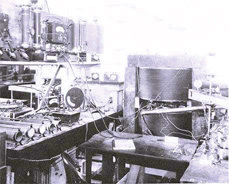June 1931: Lawrence and the First Cyclotron
  Above photo is Lawrence and Livingston around 1933, along with a photo of the Table-top cyclotron. |
Ernest Orlando Lawrence was born in August 1901 in a small town on the South Dakota prairie to parents of Norwegian ancestry. As a teenager he tinkered with radios, entering St. Olaf College in Minnesota at 16. After a year, he transferred to the University of South Dakota, where a professor of electrical engineering convinced him that his interest in radio would be well-directed towards a career in physics rather than medicine. After graduating with honors in 1922, he pursued advanced studies at the University of Minnesota with W.F.G. Swann, whom Lawrence followed to the University of Chicago and then to Yale, where he completed his PhD in 1924 with a dissertation on the photoelectric effect. Lawrence stayed on at Yale as a postdoctoral fellow, continuing his research on photoelectricity, and started work on how atoms of a gas struck by electrons are ionized.
In 1928, Lawrence joined the faculty of the University of California, Berkeley, with a position that included connections to UCB's Chemistry Department. This access to scientists and students from other disciplines was critical to Lawrence's success as a researcher and established the pattern for the unique laboratory he subsequently created.
Inspired by a paper from Norwegian engineer Rolf Wideroe, Lawrence invented a unique circular particle accelerator which became known as the cyclotron. Wideroe's concept was based on using the same electrical potential twice, doubling the energy by switching from positive to negative potential in order to push ions and then to pull them. Lawrence judged Wideroe's linear scheme impractical for light atomic particles, since it would require a vacuum tube several meters long. But it inspired him to think about how one could use the same potential multiple times instead of just once. He conceived of using a magnetic field to bend charged particles into circular trajectories and thus pass them through the same accelerating region over and over again.
The idea required a combination of sophisticated techniques: a high-vacuum chamber with electric fields varying at radio frequencies and with some means to keep the particles in a single horizontal plane. The first such device was a pie-shaped concoction of gas, sealing wax and bronze that also incorporated a kitchen chair and a wire clothes tree for operation. This prototype proved the concept worked.
Completed in the summer of 1931, the accelerating chamber of the first cyclotron measured five inches in diameter and boosted hydrogen ions to an energy of 80,000 electron volts. His assistants subsequently constructed the 11-inch cyclotron, which broke the one million electron volt (MeV) barrier, but Lawrence was already dreaming of constructing a cyclotron with an accelerating chamber 27-inches in diameter and capable of reaching energies of nearly 5 MeV. In need of more laboratory space, Lawrence procured from the university an empty building adjacent to the physics department in August 1931, which he renamed the Radiation Laboratory, or the "Rad Lab."
The 27-inch accelerating chamber of the Rad Lab's first cyclotron was soon replaced with a 37-inch chamber with an acceleration capacity of 8 MeV for deuterons and 16 MeV for alpha particles. By 1936 the machine had been used to create radioisotopes and the first artificial element, technetium. Around this time, Lawrence invited his brother, John, a physician, to join the lab and explore the use of radioisotopes in biology and medical research, culminating in the construction of the Crocker Lab, with an accelerating chamber measuring 60 inches in diameter. It began operation in 1939. That same year, Lawrence was awarded the Nobel Prize in Physics in recognition of his revolutionary device.
Lawrence's next cyclotron featured a magnet weighing 4,000 tons and an accelerating chamber 184 inches in diameter, capable of accelerating atomic particles to energies in excess of 100 MeV. To house the machine and experimental facilities needed to go with it, a permanent site for the Rad Lab was constructed on nearby Charter Hill, completed in 1946.
The development of Lawrence's cyclotron helped change our understanding of nature, from the microscopic structure of matter to human metabolism, from the process of photosynthesis to the creation of new chemical elements, including number 103 (lawrencium). Lawrence also created the model of the big-science laboratory, two of which bear his name: the Lawrence Berkeley National Laboratory and Lawrence Livermore National Laboratory. Lawrence's labs have pushed the interdisciplinary approach into such fruitful new fields as environmental research, alternative energy sources, astrophysics, and molecular biology. Lawrence died on August 27, 1958, of chronic colitis at the age of 57.
Adapted in part from an online exhibit by the American Institute of Physics History Center, "The Legacy of E.O. Lawrence." See http://www.aip.org/history/lawrence/ for the full exhibit.
©1995 - 2024, AMERICAN PHYSICAL SOCIETY
APS encourages the redistribution of the materials included in this newspaper provided that attribution to the source is noted and the materials are not truncated or changed.
Associate Editor: Jennifer Ouellette

